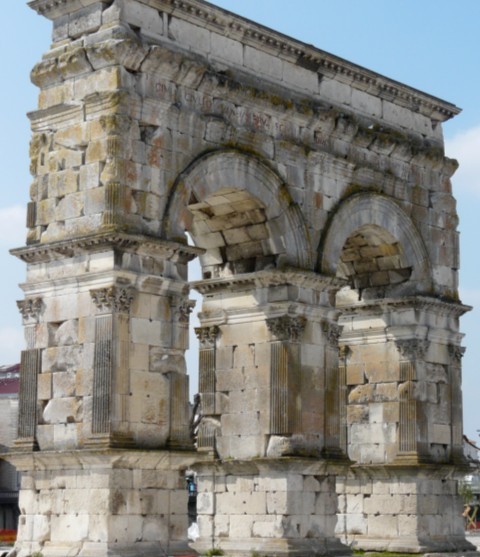New gods and new cults
The adoption of a new pantheon entailed the transformation of cults and ritual practices. From the first century onwards, the Gaulish religion's ditched enclosures, their characteristic scattered remains, and ritual pits were gradually re-developed and monumentalised along models that matched incoming practices. The adoption of a Greco-Roman type of sanctuary with its sacred space marked out by a temenos[1], of a temple that is the god's abode and of an altar for the purpose of sacrifices can be observed everywhere, whether there had been an earlier indigenous cult or not, and regardless of the style of the temple built inside the temenos. On the public squares of the civitates' administrative centres classical Roman temples became the norm as befitted the imperial cult; peripheral or out-of-town temples would henceforward fit in the framework of Roman models. Even the temples known as fana[2], which were long understood to be a continuation of indigenous tradition, seem, according to more recent analyses, to fall within the Romanisation of practices. It has coincidentally been noted that there is no mention of them before Gaul's Roman era. Furthermore they exhibit, in an admittedly original way, but still within a sacred precinct and in a frequently monumental form, the architectural elements of a classical Roman temple: cella[3] and gallery corresponding to porticoes and affording the faithful a covered space.

The frequent collocation of the sanctuaries with a theatre or amphitheatre where celebratory games took place on days dedicated to the god, and with baths for the convenience of the worshipers confirms the generalisation of Roman cult practices. Likewise the discovery of animal bones in dumps neighbouring the sanctuaries attests to sacrifices involving like in Rome the Ox-ewe-pig triad. This mainstreaming as early as the Julio-Claudian era[4] bespeaks the consensus settling around the new order. The scrutiny of the worshippers and of their cult leaders helps grasp the way in which the provincial populations were party to this transformation.
The new authorities issued no prohibition concerning former religious practices or former gods, this ran counter to the Romans' belief system wherein no divinity whatsoever should ever be offended. As against that, and with far reaching consequences, Augustus forbade Roman citizens to practice druidism[5]. Now, Roman citizenship not only came with privileges in terms of taxation and private law – marriage, inheritance, commercial rights, justice – but it also opened the way to Roman political functions. Throughout the Empire, it was the most prestigious status and the most craved by local elites. Henceforth, pre-Roman religious practice would be incompatible with the new order and, Gaulish aristocrats wishing to preserve a status equivalent to that enjoyed prior to the conquest must bow to this new order. The functions of priest of the imperial cult or of flamen to one of the new pantheon's divinities had become part and parcel of the political offices discharged in the Gallo-Roman civitates. Epigraphy brims with instances of these local grandees who proudly specify their turn of duty as flamen or priest of the imperial cult in their civitas along with their office as high ranking magistrates.
As from the Augustan age, local elites appear to accept the Rome-driven consensus around the emperor. One of the first priests of Rome and Augustus, in charge of the federal imperial cult in Lyons was also priest of the Santones' civitas and initiated the construction of a commemorative arch honouring, according to prescriptions issued by the Roman Senate, Germanicus[6], Emperor Tiberius[7]' son in law who had died in 19. The implementation of new cults thus went hand in hand with the new structuring of the peoples into civitates. This phenomenon is also attested by the first inscriptions unearthed at the sanctuary of Mars Mullo at Allonnes: the most ancient inscription to the god is owed to one Crescens, a public slave, and dates back to the Julio-Claudian era. The setting up of a cult to Mars Mullo, embodied by the building of a new temple also connotes the Aulerci Cenomani's municipalisation[8] and their introduction of roman civic formulae into their political framework. The veneration of this god would be upheld by the civitas since the site enjoyed a complete reconstruction at the turn of the 1st and 2nd centuries. Not only did the monumental sanctuary then stretch to one hectare but inscriptions would henceforward be offered by the Cenomani's civitas as confirmed by the presence of its name thereon. It is likely, although we do not have to date epigraphic evidence to the fact, that there would have been a flamen to this god as happened in Rennes: an inscription dated 135 commemorates Titus Flauius Postuminus, twice duumvir[9], and priest of the imperial cult in his civitas, and first perpetual flamen to Mars Mullo.

The elites' adhesion advanced the setting up and dissemination of the new cults in the civitates; the new formulae were thus progressively imposed to the local populations, which explains the mainstreaming of Roman style religious practice at every level of society. The cult to the new divinities protecting Roman Gaul's populations thus took Roman forms from the earliest years of our era. It was taken up by elites keen on demonstrating their loyalty to Roman power as well as preserving their desirable status. The implementation of the new political structures, granting some management autonomy to the local populations thereby encouraged the adoption of new divinities ensuring the protection of the new civic communities.






